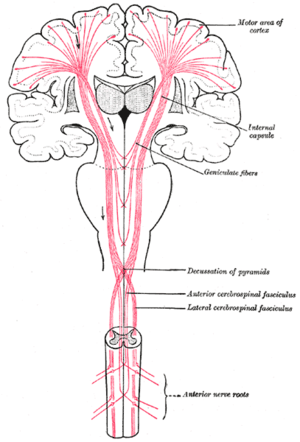Основы нейронаук/Двигательная сфера
|
Цели этого урокаправить

Нервно-мышечное соединениеправитьThe way in which the nervous system commands muscles to move is through a special type of connection, called a neuromuscular junction. At a neuromuscular junction, the axon terminal of a neuron forms a synaptic connection not with another neuron, but instead with a muscle fiber. If this neuron, referred to as a motor neuron, is electrically excited, it will release the neurotransmitter acetylcholine across the synapse. Just as in neuron-to-neuron signaling, this neurotransmitter will trigger changes in the receiving cell. The end result of these changes is that the muscle fiber contracts, hence generating movement. Произвольные движенияправить Movement that is not merely the result of a reflex arc is called voluntary movement, and may either be conscious or unconscious. The planning to execute a movement begins in a region of the cortex called the primary motor cortex, located in between the frontal and parietal lobes. Signals generated here then pass down to a complex of brain regions collectively called the basal ganglia. Here, action plans are filtered so that only some of the cortex's signals are amplified and thus sent further down the nervous system to be translated into motion, while the rest have their signals weakened and fail to pass through the basal ganglia. Those signals strong enough to pass the filter are then transmitted down through the spinal chord and out to a peripheral nerve that eventually leads to the desired motor neuron. With this motor neuron's activation, the planned motion is finally executed. When the movement to be carried out is complex and requires coordinated, the cerebellum becomes crucial. After a motor neuron triggers a muscle to contract, information is sent back to the nervous system via what is known as a muscle spindle. Once this information reaches the cerebellum, the actual executed movement can be compared to the initially intended movement. The cerebellum can make corrections that take into account the difference between what was intended and what actually occurred. The end result is a motor system capable of correcting itself and carrying out complex and delicate motor functions. Непроизвольные движенияправить While voluntary movement is a product of the brain, involuntary movement only requires the spinal chord for its processing. When some external stimulus is received at one end of the spinal chord, the grey matter nestled within the spinal chord itself interprets the stimulus and then sends a motor signal out to the appropriate motor neuron in order for the body to react. The stimulus may be something such as pain, which causes a recoiling of the body from the painful stimulus, or the feedback generated by a muscle spindle, as is the case in the classic doctor's office 'knee jerk' test. |